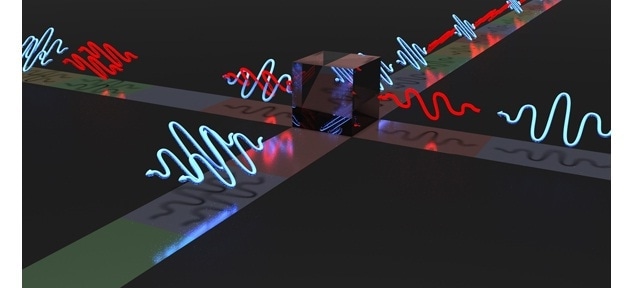Apr 6 2016
A new method developed by a group of researchers from the University of Cambridge and Toshiba Research Europe helps to address one of the key problems in the implementation of quantum cryptography system.
 Depiction of indistinguishable photons leaving through the same output port of a beam splitter. (credit: Lucian Comandar)
Depiction of indistinguishable photons leaving through the same output port of a beam splitter. (credit: Lucian Comandar)
This achievement brings the researchers one step closer to realize a practical ‘unbreakable’ method to transmit sensitive data hidden inside light particles.
Using their method to ‘seed’ one laser beam within another beam, the researchers have successfully distributed encryption keys at rates between two and six orders of magnitude more than previous efforts at a practical quantum cryptography system. The study findings have been reported in the Nature Photonics journal.
As a key component of modern life, encryption enables secure sharing of sensitive data. The key or encryption code is decided by the sender and receiver of a specific piece of data in the case of traditional cryptography, enabling decryption of the information only by those who have the key with them. However, conventional encryption codes become easier to break due to the advent of faster and more powerful computers.
The ability to hide data in light particles or photons released by lasers allows quantum cryptography to provide ‘unbreakable’ security of the information being transmitted. In quantum cryptography, a key is generated randomly using quantum mechanics. The sender (Alice) transmits the key through polarized photons that travel in different directions. The receiver (Bob) measures the direction of polarization of the photons using photon detectors, which convert the photons into bits. Bob will get the key if he has utilized the appropriate photon detectors in the exact order.
If an attacker attempts to intercept the information, the key changes by itself, due to the characteristics of quantum mechanics – a key advantage of a quantum cryptography system. Quantum cryptography was originally proposed in the 1980s and since then, it has promised the potential of unbreakable security.
In theory, the attacker could have all of the power possible under the laws of physics, but they still wouldn’t be able to crack the code.
Lucian Comandar, PhD Student, Department of Engineering, Cambridge
However, researchers face problems when they attempt to build a practical quantum cryptography system. It can be considered a back and forth game, where inventive attacks targeting various system components are continuously being developed, and counteractions are continuously being developed to respond such attacks.
The photon detectors are most frequently targeted by hackers due to their complex design and high sensitivity. Generally, they are the most sophisticated components but are the most susceptible to attacks. To handle these attacks, a new quantum cryptography protocol called measurement-device-independent quantum key distribution (MDI-QKD) has been developed by researchers.
The MDI-QKD protocol uses a central node (Charlie) to receive the photons from Alice and Bob. The photons are allowed to traverse a beam splitter and are subsequently measured by Charlie. The results reveal the relationship between the bits, but their values will remain undisclosed. In this configuration, the information security can be ensured even if Charlie tries to betray.
Although the experiential demonstration of the MDI-QKD protocol has been successfully carried out, the data transfer rate is not adequate for practical applications, mainly because of the challenges in generating indistinguishable particles from various lasers. For proper function of the system, relatively long laser pulses must be transmitted through Charlie’s beam splitter, limiting rates to a few hundred bps or low.
The Cambridge researchers proposed a pulsed laser seeding technique to overcome the problem, injecting photons into a laser beam using another beam. As a result, Charlie can easily see the laser pulses due to the reduced level of ‘time jitter’ in them. This enables the use of much shorter pulses. The laser beam phase can also be randomly changed at very high rates using the pulsed laser seeding technique, allowing rates of up to 1 megabit per second in the MDI-QKD setup. As a result, two to six orders of magnitude of improvement can be achieved when compared to earlier attempts.
This protocol gives us the highest possible degree of security at very high clock rates. “It could point the way to a practical implementation of quantum cryptography.
Lucian Comandar, PhD Student, Department of Engineering, Cambridge